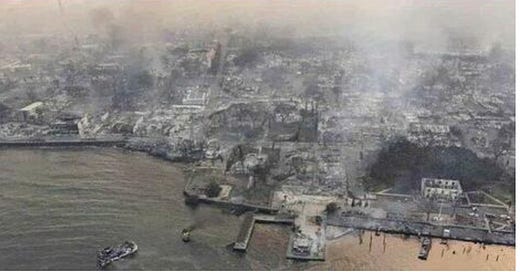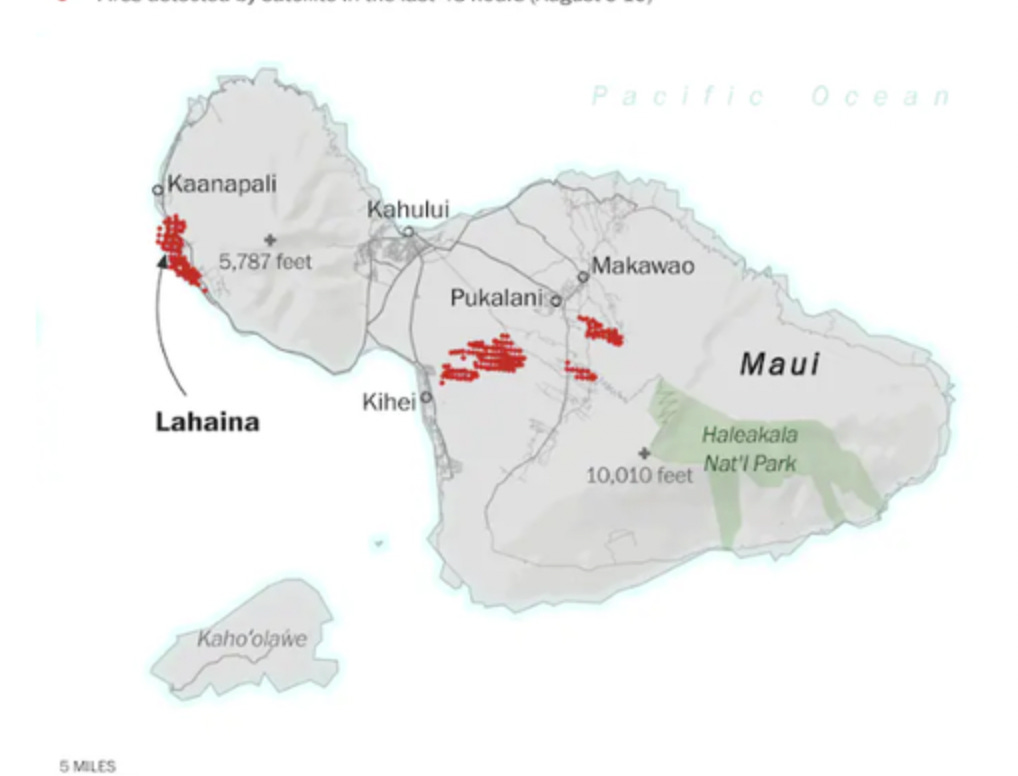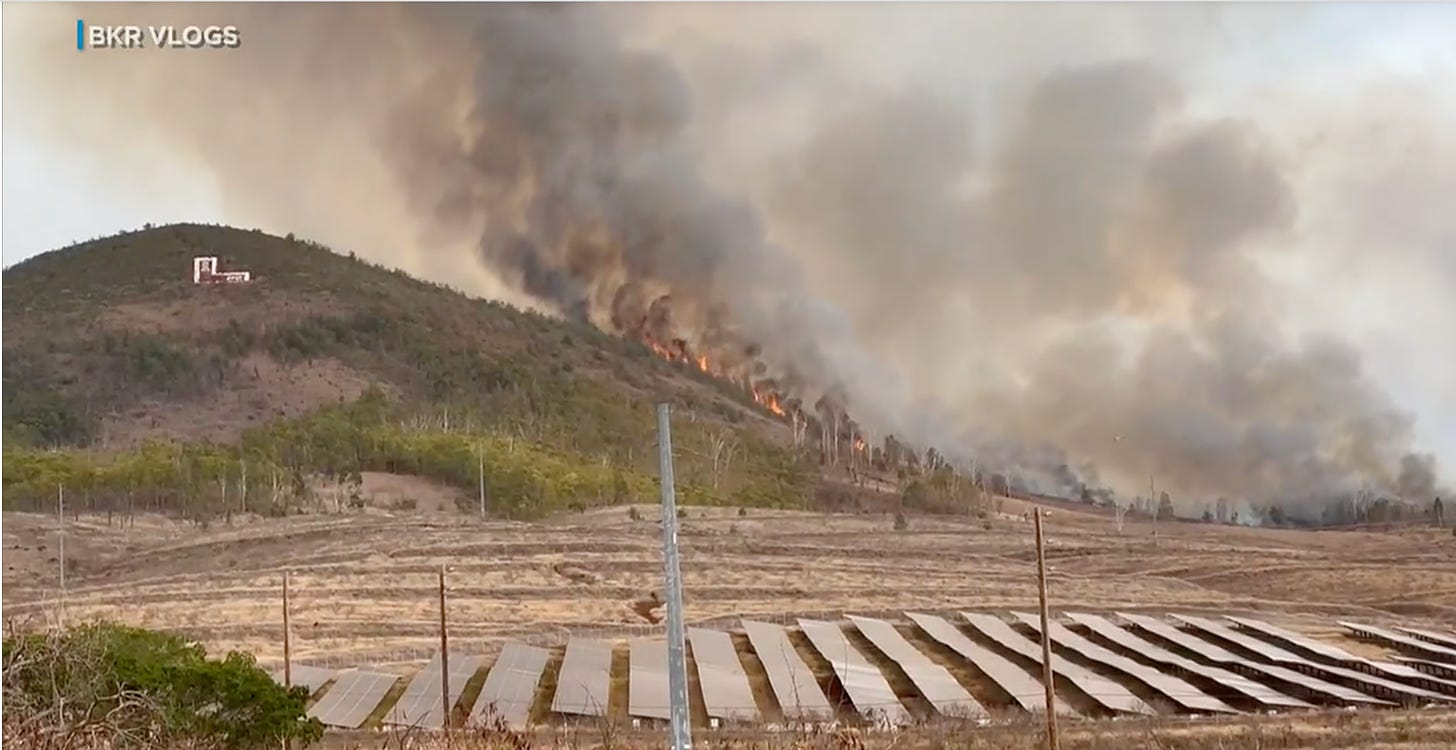By John Leake
My brother lives on Maui, and I spoke with him briefly yesterday about the situation in Lahaina. A general contractor, he has a heavy truck and trailer that he was using to deliver supplies to the devastated town. The fire burned so hot that the molten aluminum from cars ran down the streets like lava flows. People trying to escape the searing heat jumped into the Lahaina Harbor and swam for the open ocean, which reminded me of Pliny the Younger’s descriptions of the Pompeii disaster in 79 AD.
In modern societies such as ours, we are generally inclined to believe that our high tech infrastructure and understanding of floods and fires have advanced to the point that we should no longer anticipate catastrophes such as the Lahaina fire. However, for my part, I have long perceived that Lahaina was highly vulnerable to total incineration.
First, consider the geography of it’s location:
The historic town is situated on the west side of the West Maui Mountains. The prevailing trade winds carry moisture from the east, but when the moisture-laden wind encounters the mountains, the water precipitates out on the eastern slope. The result is that the eastern slope is one of the wettest places on earth, and the western slope (above Lahaina) is extremely arid, especially in the summer months.
Maui has a monsoon climate, with heavy rains in the winter and spring months, and dry summers. During the summer months, Lahaina is one of the hottest places on the island. One of my favorite summer surf breaks is Breakwall, right next to the Lahaina boat harbor.
My brother usually declines to join me because it is so damned hot. Here I am at the Breakwall parking lot in the summer of 2019, about to head out, my face armed with zinc sunscreen against the punishing sun.
So, in the summer you have extremely hot and dry conditions, and the historic town of Lahaina was built almost entirely out of wood.
The hillside above the town is a large expanse of dry ground. For much of Lahaina’s history, these fields were irrigated for sugarcane and pineapple. Irrigation ceased with the end of these industries, and the fields have been colonized by grass that desiccates in the summer and creates fuel. You can really see this danger in this photo of the early stage of the fire, when the wind was blowing out of the southwest.
WIND is a primary ingredient for a raging inferno. Pressure systems in the Pacific can cause the trade wind to blow very hard, with gusts up to 40 mph. Most of the time, Lahaina is in the lee of the West Maui Mountains, but when the trade wind veers out of the north, it can gust down to Lahaina. The town also occasionally experiences gusting katabatic winds down the western slope of the West Maui Mountains.
Finally, and most importantly in this case, is the occasional hurricane that runs south of the Hawaiian Islands. IF the hurricane brings heavy rain to the islands, it tends not to pose a fire threat. Hurricane Dora did NOT bring rain to Maui, but it did strike the island with 80 mph gusts, acting just like a blast furnace. In canyons and gulches, the Venturi effect greatly increases wind velocity.
When struck with an 80 mph wind, power lines often go down and their current can arc and cause a fire. In 2018, Hurricane Lane gave Maui and Oahu a major wakeup call, burning nearly 3,000 acres of land, displacing dozens of homeless residents and destroying 21 structures.
Speaking of homeless residents, they too can present a fire risk, because many of them dwell in wooded areas along beaches and on the fringes of fields that can become very dry in the summer. An improperly extinguished campfire, cigarette, or joint can quickly turn into a conflagration.
Finally, there are documented instances on Maui in which public announcements of heightened fire risk have, paradoxically, inspired criminally disordered individuals to commit acts of arson.
In other words, it was probably just a matter of time before Lahaina was destroyed by fire. And though it is far too early to raise suspicions of neglect, I can’t help wondering if far more could have been done to prevent the disaster.
For starters, once it became evident that Hurricane Dora was blasting the island with 80 mph winds on the tinder dry South and West sides, I wonder if it would have made sense to shut down the power lines until the wind backed off. In recent years, California power companies have started doing this in dry areas affected by high velocity Santa Ana Winds.
It’s hard for me to express how saddened I am by the destruction of Lahaina, which was one of my favorite places on earth. This photograph captures the magic of summer mornings and sunsets, looking back towards the West Maui Mountains from the water.
I have often thought those summer days surfing at Breakwall were some of the happiest of my life. Goodbye, Lahaina. I will miss you.










What is going on in Hawaii is hardly a natural disaster. If you look at the destruction and all the fires that just unbelievably started all at the same time, it was an obvious intentional act by some very malicious people. It’s bullshit to suggest this is somehow climate change. Why would cars melt while trees around it still stand. I saw a picture showing. This was the result of a laser beam, which obviously would come from a satellite. Why aren’t people investigating this. This was a criminal mass of murdering act.
Thank you for writing this lovely tribute and explanation. I live on Maui—although I'm currently traveling on the mainland. Gratefully my friends and my home are all safe. But Lahaina Towne was the historical heart of Maui ... its grace and beauty are already sorely missed.